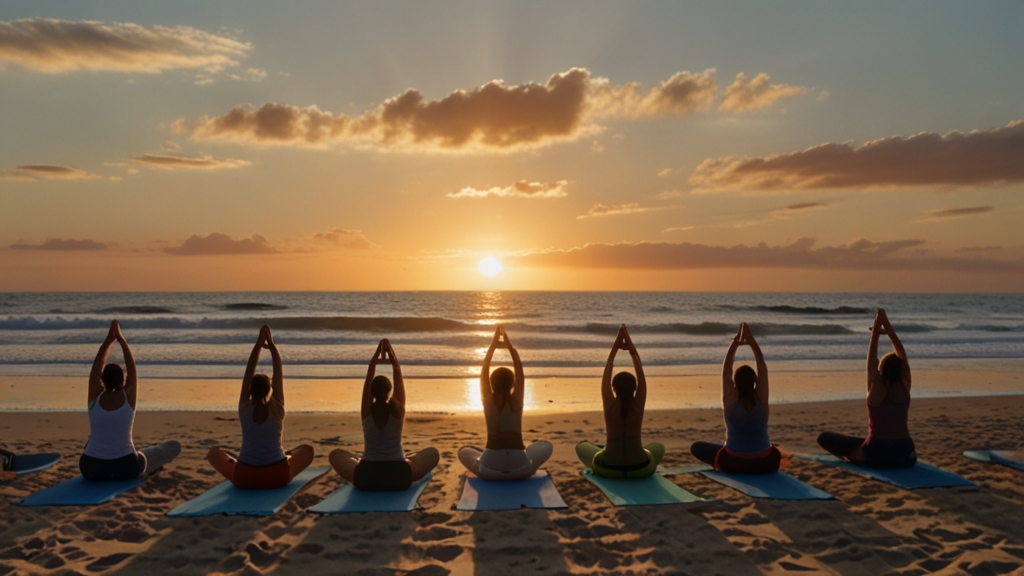Yoga is an ancient practice that offers numerous physical, mental, and emotional benefits. For those new to the practice, it can seem overwhelming, but with the right guidance, anyone can start enjoying yoga. This complete guide on "Yoga for Beginners" will help you understand what yoga is, its benefits, and how you can get started with basic poses and tips to ensure a smooth journey.
What is Yoga?
"Yoga for Beginners" often starts with understanding the basics of what yoga really is. Yoga originated in India over 5,000 years ago and combines physical postures (asanas), breathing techniques (pranayama), and meditation to promote holistic health and wellness. Yoga is more than just exercise; it is a way to connect the body and mind, helping you achieve a state of balance and tranquility.
The Amazing Health Benefits of Moringa, What You Should Know, How to Use Moringa
Benefits of Yoga for Beginners
Starting yoga offers a wealth of benefits, especially for those new to fitness or mindfulness practices. Here are some key benefits of Yoga:
- Improves Flexibility and Strength: One of the primary reasons people start yoga is to improve flexibility. Over time, yoga poses help stretch and lengthen muscles, enhancing overall flexibility. Strength-building is another key benefit, especially in the core, arms, and legs.
- Reduces Stress and Promotes Relaxation: "yoga" is an excellent way to reduce stress and anxiety. Through mindful breathing and relaxation techniques, yoga helps lower cortisol levels, promoting a calm and peaceful state of mind.
- Enhances Posture and Balance: Many beginners struggle with posture and balance. Yoga helps align the body properly, which can prevent injuries and improve overall posture. Balancing poses, in particular, are great for enhancing stability.
- Boosts Mental Clarity and Focus: A consistent "Yoga for Beginners" practice can improve concentration, mental clarity, and focus. The mindfulness aspect of yoga trains the brain to stay present, which is beneficial in daily life.
- Supports Weight Management: While yoga is not typically associated with intense calorie burning, styles like Vinyasa or Power Yoga can aid in weight management. yoga often leads to healthier eating habits as it encourages mindfulness in all areas of life.
- Improves Respiratory Health: Breathing exercises in "Yoga for Beginners," such as pranayama, enhance lung capacity and respiratory function, which is beneficial for overall health and well-being.
- Fosters a Strong Mind-Body Connection: Yoga is all about connecting with your body. Yoga encourages awareness of physical sensations, emotions, and thoughts, leading to a deeper understanding of oneself.
Getting Started with Yoga for Beginners: What You Need
Embarking on your Yoga journey requires minimal equipment but having the right tools can make your practice more comfortable and enjoyable:
- Yoga Mat: A quality yoga mat provides cushioning and prevents slipping during poses. It's an essential item for every beginner.
- Comfortable Clothing: Wear loose-fitting or stretchy clothing that allows you to move freely. Avoid anything too tight or restrictive.
- Water Bottle: Staying hydrated is important, especially if you're doing more vigorous forms of yoga.
- Optional Props: Yoga blocks, straps, and bolsters can provide additional support, making poses more accessible for beginners.
The Ultimate Guide to Home Exercises for Weight Loss: 5 Effective Workouts to Shed Pounds Fast
Basic Yoga Poses for Beginners
As you begin your "Yoga for Beginners" practice, it's important to start with basic poses that are easy to learn and perform. Here are ten essential yoga poses for beginners:
- Mountain Pose (Tadasana)
- Purpose: A foundational pose in Yoga that improves posture and balance.
- How to Do It: Stand tall with feet together, arms at your sides, engage your thighs, and lift your chest. Hold for several breaths, focusing on stability.
- Downward-Facing Dog (Adho Mukha Svanasana)
- Purpose: A staple in "Yoga for Beginners," this pose stretches the entire body and strengthens the arms and legs.
- How to Do It: From your hands and knees, lift your hips up and back, forming an inverted V shape. Keep your spine straight and press your heels toward the floor.
- Child’s Pose (Balasana)
- Purpose: A resting pose that’s great for beginners to use between challenging poses to reset and relax.
- How to Do It: Kneel on your mat, sit back on your heels, and fold forward with your arms extended. Breathe deeply as you relax your body.
- Warrior I (Virabhadrasana I)
- Purpose: Strengthens the legs and opens the hips and chest, a powerful pose in "Yoga for Beginners."
- How to Do It: Step one foot forward into a lunge, turn your back foot out slightly, and raise your arms overhead, palms facing each other.
- Warrior II (Virabhadrasana II)
- Purpose: A pose that builds strength in the legs and encourages focus and concentration in Yoga
- How to Do It: From Warrior I, open your arms to the sides and turn your torso to face sideways, ensuring your front knee stays aligned over your ankle.
- Tree Pose (Vrksasana)
- Purpose: A classic balance pose in Yoga that enhances stability and focus.
- How to Do It: Stand on one leg, placing the other foot on your inner thigh, and bring your hands together at your heart or overhead.
- Cat-Cow Pose (Marjaryasana-Bitilasana)
- Purpose: Increases flexibility in the spine, a gentle flow that's great for warming up in Yoga.
- How to Do It: On hands and knees, alternate between arching your back (Cow) and rounding it (Cat), syncing the movements with your breath.
- Bridge Pose (Setu Bandhasana)
- Purpose: Strengthens the back and glutes, a gentle backbend suitable for "Yoga for Beginners."
- How to Do It: Lie on your back, bend your knees, and lift your hips off the mat, keeping your feet and shoulders grounded.
- Cobra Pose (Bhujangasana)
- Purpose: Opens the chest and strengthens the back, a great pose to counteract sitting in Yoga.
- How to Do It: Lie on your stomach, place your hands under your shoulders, and gently lift your chest off the mat while keeping your elbows close to your sides.
- Savasana (Corpse Pose)
- Purpose: A relaxation pose that helps absorb the benefits of practice, essential in "Yoga for Beginners."
- How to Do It: Lie flat on your back, arms at your sides, palms facing up, and close your eyes. Relax and breathe deeply, letting go of all tension.
Intermittent Fasting for Beginners: A Guide to Boosting Weight Loss and Energy
Tips for Yoga for Beginners
Here are some tips to help you get started with Yoga and ensure a positive and safe experience:
- Start Slow and Be Patient: yoga is all about easing into the practice. Begin with gentle poses and short sessions, gradually increasing the duration and intensity as you build confidence.
- Listen to Your Body: Yoga is not about forcing your body into poses. In yoga it's crucial to listen to your body and modify poses as needed to avoid strain or injury.
- Focus on Your Breath: Breathing is an integral part of yoga. Yoga concentrates on maintaining a steady breath, and try to sync your breath with your movements for a more mindful practice.
- Be Consistent: Consistency is key in "Yoga for Beginners." Try to practice regularly, even if it’s just a few minutes a day. This will help you build a solid foundation and see progress over time.
- Explore Different Styles: There are many styles of yoga, such as Hatha, Vinyasa, and Yin. As you progress in Yoga, explore different styles to find what resonates best with you.
- Seek Guidance from a Teacher: While there are many resources available online, attending a class or hiring a certified instructor can be invaluable for Yoga. A teacher can provide personalized guidance and help you correct your form.
Common Mistakes in Yoga
Avoiding common mistakes can help you get the most out of your Yoga practice:
- Comparing Yourself to Others: Remember that Yoga is your personal journey. Focus on your own progress rather than comparing yourself to others in class or online.
- Skipping Warm-Ups: Always start your Yoga session with gentle warm-up poses to prepare your body and prevent injuries.
- Holding Your Breath: In Yoga maintaining a steady breath is crucial. Avoid holding your breath, especially in challenging poses, as this can cause tension and discomfort.
- Overstretching: Pushing your body too far too soon can lead to injuries. In Yoga, ease into each pose and respect your body’s limits.
- Ignoring Alignment: Proper alignment is essential in Yoga to maximize benefits and prevent injuries. Use mirrors, or seek guidance to check your form.
FAQs About Yoga for Beginners
Q: How often should I practice yoga as a beginner?
A: For Yoga, starting with 2-3 times per week is ideal. As you become more comfortable, you can increase the frequency and duration of your sessions.
Q: Can I practice yoga if I’m not flexible?
A: Absolutely! Yoga is designed for all levels, including those with limited flexibility. Yoga poses can be modified, and with regular practice, your flexibility will improve.
Q: Is yoga suitable for all ages?
A: Yes, Yoga is suitable for all ages. There are modifications and styles tailored to different fitness levels, making yoga accessible for everyone from kids to seniors.
Q: What should I eat before a yoga session?
A: It’s best to practice "Yoga for Beginners" on an empty stomach or have a light snack at least an hour before. Avoid heavy meals before yoga to prevent discomfort.
Q: How can I avoid injuries while practicing yoga?
A: To avoid injuries in Yoga, focus on proper alignment, listen to your body, and don’t force yourself into poses. Use props if needed, and warm up properly before each session.
Q: Is yoga a religious practice?
A: While yoga has spiritual roots, Yoga and modern yoga, in general, are practiced primarily for health and wellness. It does not require any specific religious beliefs.
Conclusion
"Yoga for Beginners" is a rewarding practice that can transform your physical and mental well-being. By starting slow, listening to your body, and practicing consistently, you'll build a strong foundation that will support your growth in yoga. Remember, the journey of Yoga is not about perfection but about progress, self-discovery, and enjoying the present moment.




